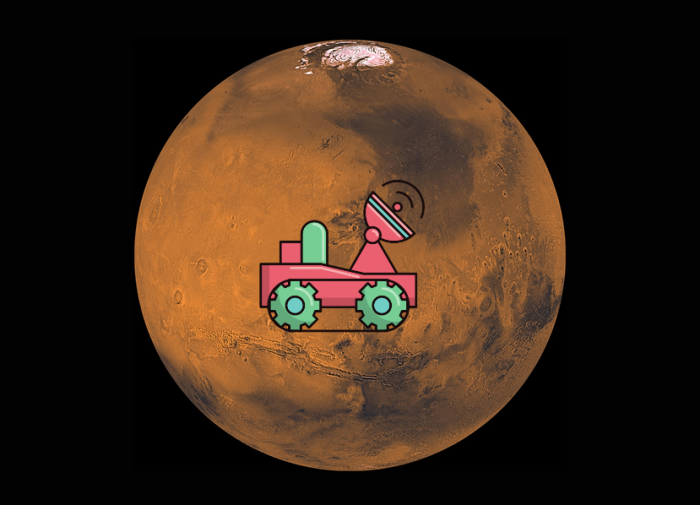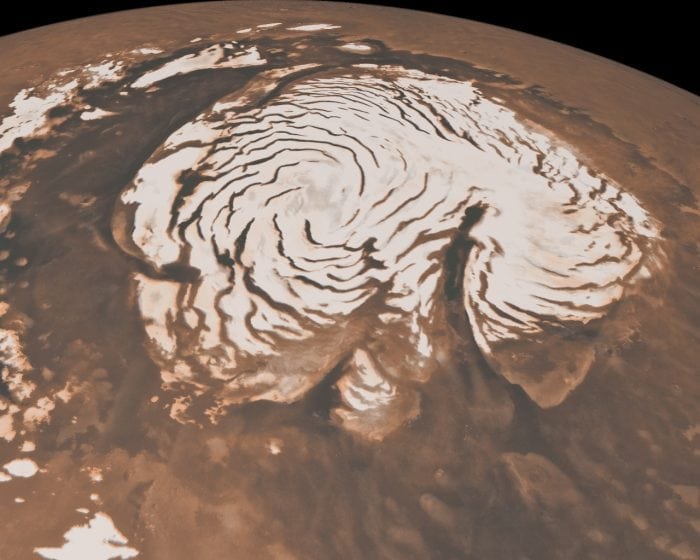
Scientists have officially found deposits of water on Mars. To be more specific, scientists have found multiple large sheets of ice tucked away under Mar’s surface. This discovery isn’t a shock to researchers because they have known for a while that Mars was hiding water somewhere, but now we actually know where the ice is.
NASA has found 8 sites where there appear to be large ice deposits that are somewhat close to the surface, NASA estimates that they’re covered in about 1 to 2 yards of rocks. In the picture below the ice is highlighted blue, and you can see that it is sandwiched by the Martian surface.
“Mars tugs at the human imagination like no other planet. With a force mightier than gravity, it attracts the eye to the shimmering red presence in the clear night sky.” — John Noble
These deposits, like what you see below, are substantially large, possibly 100 meters thick. These scarps that they’ve found the ice under is actually steep, which tells researchers that the ice is newer, possibly 1 million years old or younger.
You might be wondering just who we have to thank for this discovery, and it is none other than the Mars Reconnaissance Orbiter (also called the MRO). It was able to use high resolution imagining equipment to look at scarps on the Martian surface and see the ice deposits. NASA scientists believe that these ice pockets were actually from snow long ago, but we don’t really 100% know just yet. So far NASA has found 8 of these deposits, but the high imaging that the MRO is performing has only seen about 3% of the Martian surface, meaning that the likelihood of finding more ice deposits is very high. What’s important is that these locations are located near Mars’ equator, not towards the poles. Humans will be able to have an easier time living at the equator of the planet as opposed to the harsher temperatures at the north and south pole of the planet.
“Mars is there, waiting to be reached.” — Buzz Aldrin
One aspect of this discovery is that these ice layers can actually teach us a lot about the history of Mars to help us further understand this planet that has captured the attention of so many people. Scientists can look at the composition of the ice to see just what is in it, and from that, they can determine the makeup of Mar’s ancient atmosphere. Like we said above, NASA thinks that the ice deposits are from snow long ago in Mars’ history, so the minerals and composition can teach us a lot about Mars. The scientists who discovered the ice deposits believe that the ice is actually subliminating, meaning that it is shrinking as time goes on. They believe that this is happening because there are fairly sizable chunks of rocks that have fallen into the ice.
The other major aspect of this discovery is based on the future of humankind on Mars. One of the members of the team who made this incredible discovery is Shane Byrne, who works at the University of Arizona Lunar and Planetary Laboratory, who stated about human consumption of the ice, “Astronauts could essentially just go there with a bucket and a shovel and get all the water they need”. Obviously, this has many space nerds really stoked at this discovery, but what are the implications of this discovery?
What does this mean for Mars colonization?
Mars is the only place in the solar system where it’s possible for life to become multi-planetarian. – Elon Musk
The discovery of these large ice pockets leads to even greater questions; what does this mean for colonizing Mars? Does this even affect colonization? What could we use the water for?
With this discovery, and taking into account what Byrne said, it is extremely possible (in fact probable) that NASA will land our first manned mission near, or on, the places on Mars that have these ice deposits. We would have to pack up our astronauts with drills so they can drill down into where the ice deposits are to get to that resource. That would make living long term on Mars easier since the water is quite literally right there, and it would mean that NASA and other agencies wouldn’t have to pack an insane amount of water for our astronauts.
Some people have also brought up the idea that the water can be used to power space vehicles for astronauts to drive around in, which would be incredible. Imagine exploring this alien land and having the capabilities of using the same resource you need to live being used to also power a vehicle so you can really explore and learn all you can about Mars. Again, this will cut down the weight for the actual trip to Mars itself, and it might be possible that the brainiacs at NASA can make that water used for fuel recyclable so it can continue to help our astronauts. Now that scientists know that Mars has accessible ice then we can expect to see some great strides in the technology that we will be using on Mars.

Beyond our exploration of Mars, this discovery makes a huge impact on the actual colonization of Mars. It’s no secret that humans are looking to the Red Planet with the hopes of colonization. NASA, SpaceX, Boeing, and many other companies are looking into that possibility. Heck, SpaceX, (the brainchild of our favorite honorary Martian Elon Musk) was born with the sole intent of colonizing Mars.
One of the biggest problems that researchers and companies are trying to find an answer to is where they can get water for Martian colonies. Before this discovery, we had to come up with an answer to how we were going to keep a constant supply of water on a planet that had no water. Yes, scientists have known that there was water on Mars for a while but didn’t know how far we would have to drill to find it or if that ice was even accessible. Now we know that the ice deposits are within reach and can be accessed without too much trouble. This doesn’t mean all our issues can be immediately answered, but it does provide some answers. We do believe that this will help speed up actually going to Mars since we at least know there is water.
“I think it would be great to be born on Earth and die on Mars. Just hopefully not at the point of impact.” — Elon Musk
Once we can get more images of the locations of other ice deposits we can start to plan locations for our colonies to have them near the deposits. We could not only provide the necessary water to live, but we could use the deposits to make greenhouses to grow plants needed for food and can even take the basic makeup of the ice to provide oxygen to the people in the colonies. All of these theories and ideas will obviously be tested and simulated like there is no tomorrow to see what is probable and what isn’t, but we now have a good starting point for water on Mars.
This discovery is one of the biggest milestones we have had in regards to Mars in quite a long time. This opens up so many opportunities and ideas that seemed impossible even a week ago and allows scientists and researchers to start working on concepts of making that ice accessible for human use once we begin our manned missions to Mars. Before that happens though, we need to learn a little bit about the ice.
Breaking The Ice

Northern ice cap of Mars. Image source: NASA
Before we can rely on the ice on Mars to sustain human life, scientists need to test it to learn what it consists of. For all we know the ice is poisonous or dangerous to humans (although that is doubtful), so we need to test it. To test it we will need some kind of rover with a drill long enough to examine the ice, which is where the ExoMars Rover will come in to play. This rover has already been in the works and has been scheduled for launch in 2020, but now it can really aid us by going to the places we know ice is to test it. This rover has a drill capable of drilling down 2 meters, which happens to coincide perfectly with the depth of the ice deposits. This rover will have the equipment on it to be able to test the ice deposits over Mars to determine the properties and makeup of the ice. Not only will this rover learn for sure if the ice will be good for human use, it will also give us insight into Mars’ atmosphere and history that much sooner.
The ExoMars Rover will be launched in 2020 by the European Space Agency (ESA for short), and its main mission is to actually search for any signs of life on Mars. With it having the capabilities of reading the Martian life, it may very well be the rover to create human life on Mars. Or at least provide the opportunity for life on Mars. We eagerly await to hear the results from the ice, but one this is for sure; our plans for Mars changed drastically with this one discovery and the future is very exciting and bright for Mars colonization.









